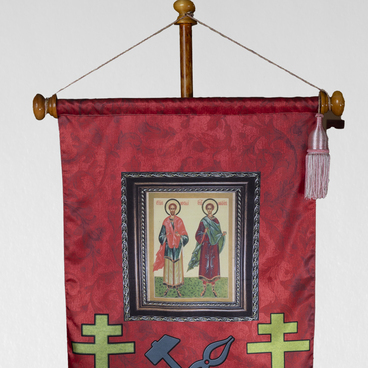Goldsmiths and silversmiths were called “zolotary” in Pogar. They produced goblets, cups, pieces of jewelry, church utensils, and icon revetments. The zolotary’s guild was established in 1789. It was headed by Yakiv Dobry.
Each guild in Pogar formed a fraternity. It worked for charitable causes: craftsmen built churches, schools, almshouses which attended to sick and elderly people, as well as a fraternity house that was used for holding meetings and celebrating patronal festivals.
A guild’s khorugv was also kept there. Its pole featured a banner depicting a cross with holy images or an icon decorated with fringes and tassels. Brocade or velvet fabric banners with icons were embroidered with gold, and poles were made of wood. Especially heavy banners featured fittings to be carried by four people. Guild members also participated in cross processions. Khorugv-bearers put on sticharion — special wide-sleeved long clothes. Khorugvs were always carried by their guild’s craftsmen and only with the priest’s blessing
The zolotary’s khorugv depicts the Holy Trinity image and the guild emblem with a chalice — a vessel for church service. The year of the guild’s establishment, the name and last name of the guild’s head were indicated there as well.
The guild was part of the Holy Trinity Church fraternity. It was first mentioned in the chronicles of 1690. In 1717, a Pogar sotnik Zachary Iskra constructed a new wooden church replacing the run-down building. In 1783, a stone building was built when Pogar was given the status of the chief town of uyezd. Later, a small refectory was added to the building. In the 19th century, all Pogar processions of the Cross started from the Holy Trinity Church; the locally venerated Trinity Icon of the Mother of God was carried in front of the procession.
The old wooden church was sold and transferred to the village of Gorodishche, Pogar district. At this very place, the church was consecrated in honor of the Elevation of the Holy Cross.
After the 1917 revolution, the church was looted and closed. The church premises were used as a warehouse.
Because of this, unfortunately, all the interior decoration was lost, not even a fragment of the frescos that coated the church walls has survived to this day.
The church was reopened in 1946 and it is still functioning.
Each guild in Pogar formed a fraternity. It worked for charitable causes: craftsmen built churches, schools, almshouses which attended to sick and elderly people, as well as a fraternity house that was used for holding meetings and celebrating patronal festivals.
A guild’s khorugv was also kept there. Its pole featured a banner depicting a cross with holy images or an icon decorated with fringes and tassels. Brocade or velvet fabric banners with icons were embroidered with gold, and poles were made of wood. Especially heavy banners featured fittings to be carried by four people. Guild members also participated in cross processions. Khorugv-bearers put on sticharion — special wide-sleeved long clothes. Khorugvs were always carried by their guild’s craftsmen and only with the priest’s blessing
The zolotary’s khorugv depicts the Holy Trinity image and the guild emblem with a chalice — a vessel for church service. The year of the guild’s establishment, the name and last name of the guild’s head were indicated there as well.
The guild was part of the Holy Trinity Church fraternity. It was first mentioned in the chronicles of 1690. In 1717, a Pogar sotnik Zachary Iskra constructed a new wooden church replacing the run-down building. In 1783, a stone building was built when Pogar was given the status of the chief town of uyezd. Later, a small refectory was added to the building. In the 19th century, all Pogar processions of the Cross started from the Holy Trinity Church; the locally venerated Trinity Icon of the Mother of God was carried in front of the procession.
The old wooden church was sold and transferred to the village of Gorodishche, Pogar district. At this very place, the church was consecrated in honor of the Elevation of the Holy Cross.
After the 1917 revolution, the church was looted and closed. The church premises were used as a warehouse.
Because of this, unfortunately, all the interior decoration was lost, not even a fragment of the frescos that coated the church walls has survived to this day.
The church was reopened in 1946 and it is still functioning.



